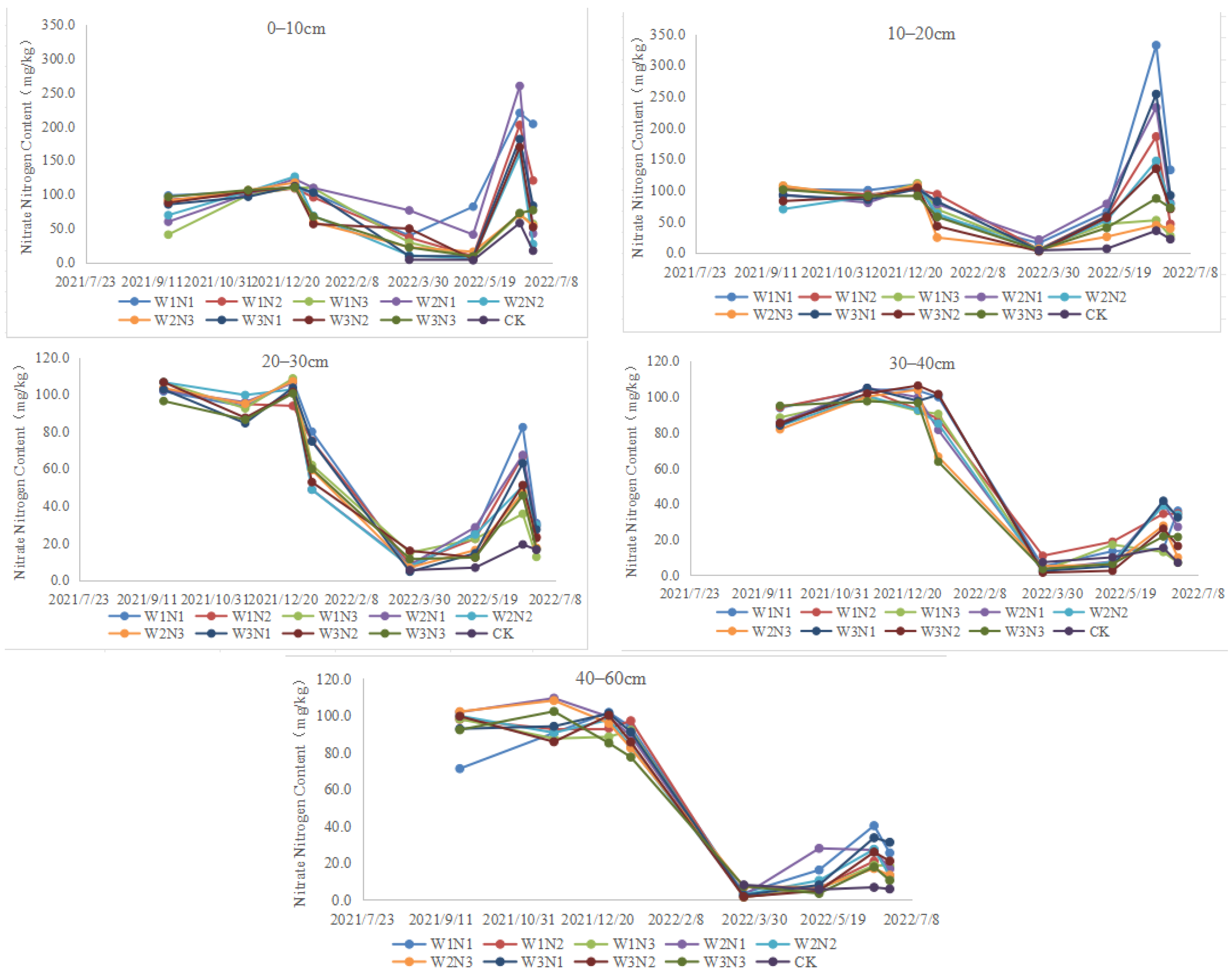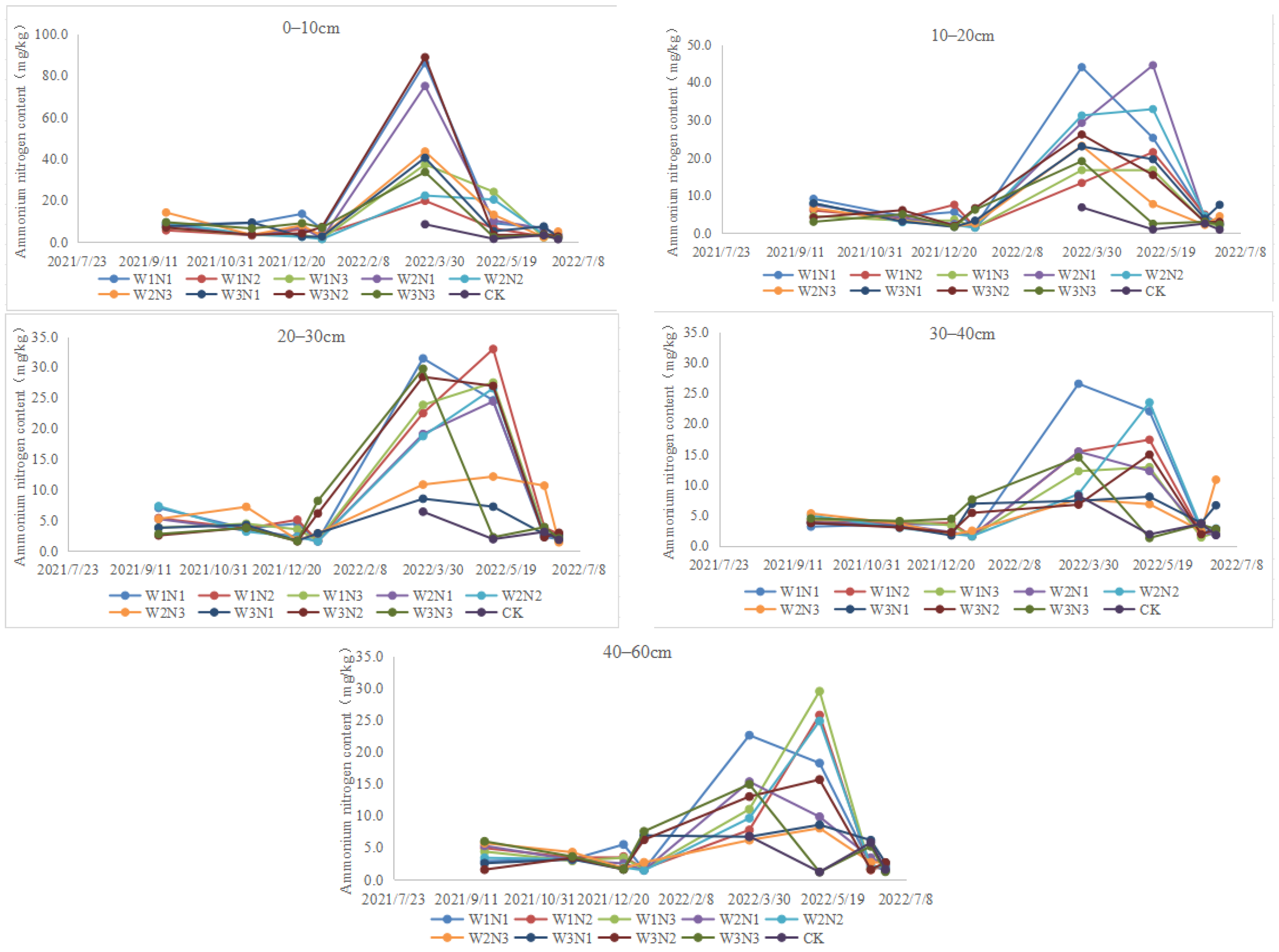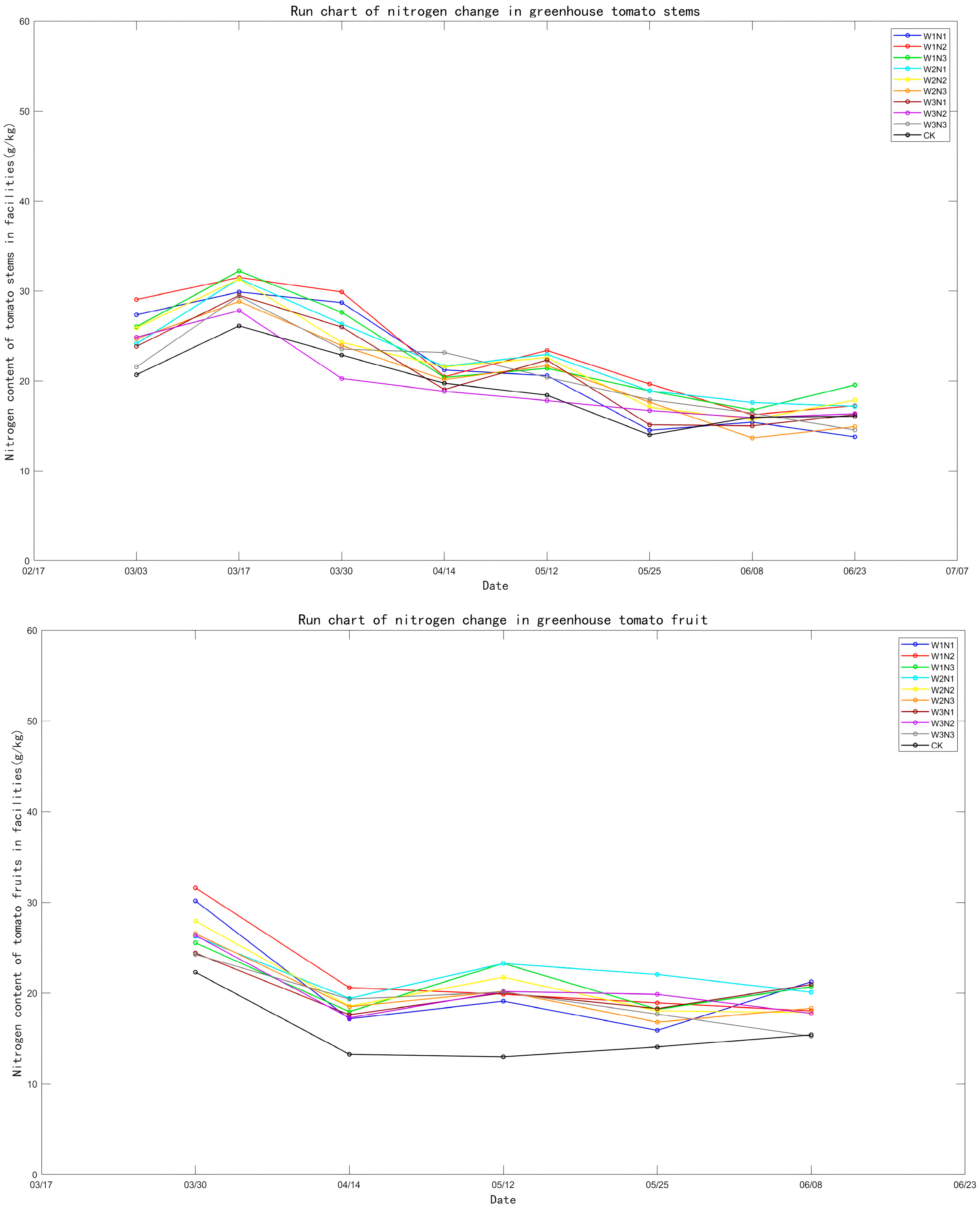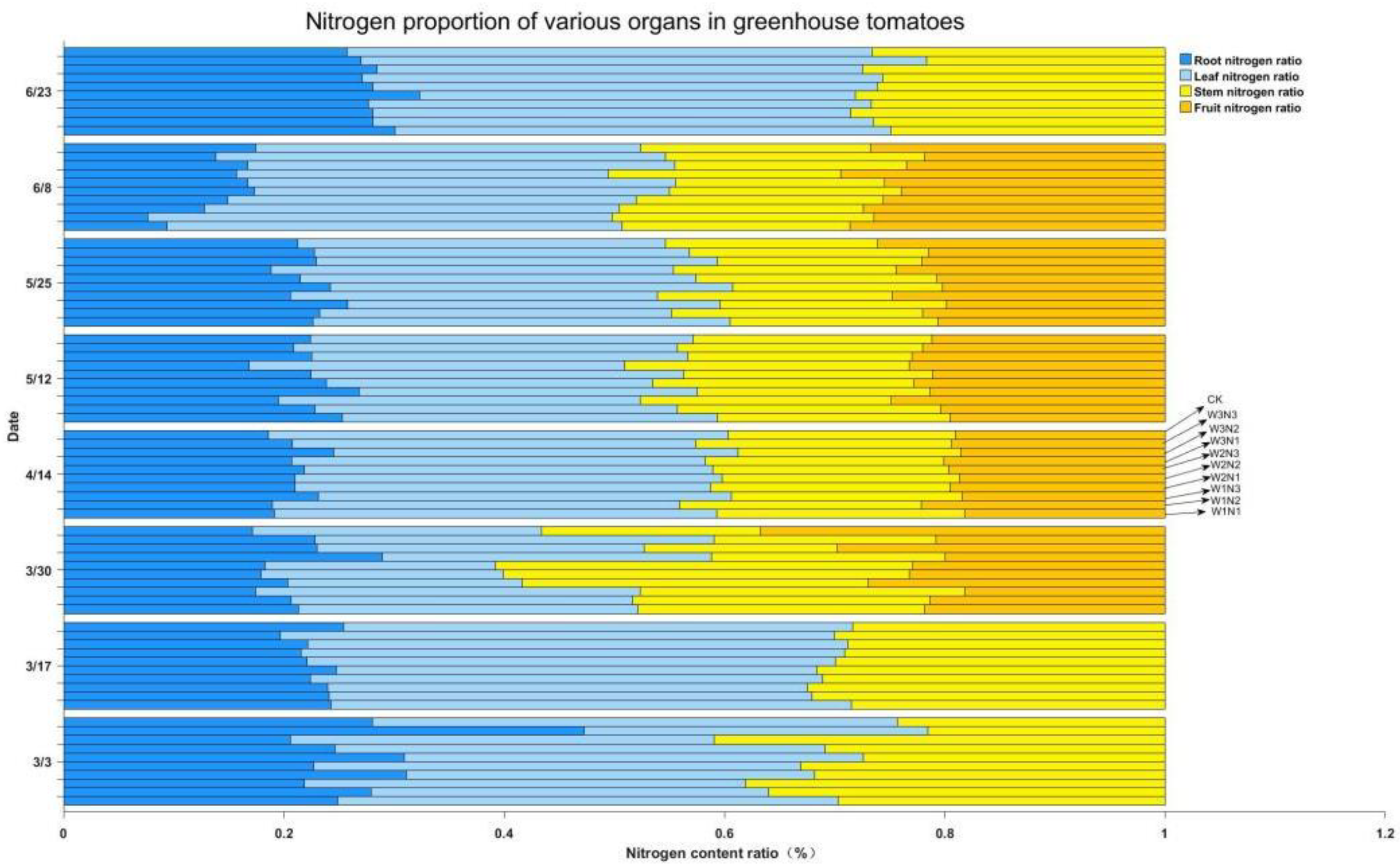1. Introduction
Vegetable production is an important part of China’s agriculture. In 2021, China’s vegetable sowing area was 21.986 million hectares, accounting for 13.03% of the total crop sowing area [
1].
The cultivation of facility-grown vegetables in China has flourished in recent years, with the total area of production growing from 1.2 million hectares in 1999 to approximately 3.87 million [
2,
3] hectares today. However, the majority of these crops are shallow-rooted, meaning they are not particularly sensitive to soil moisture and nutrient levels. As a result, many farmers have become accustomed to using high levels of fertilizers and frequent irrigation to maintain their production processes. Unfortunately, this has led to excessive levels of nitrogen in the soil in many cases, with nitrogen fertilization often exceeding the actual demands of crops [
4]. In some cases, it has been found that the average amount of nitrogen fertilizer used in vegetable fields in Beijing’s suburban areas is as high as 1741 kg/hm
2 [
5], which is much more than the demand for vegetables themselves [
6]. Similarly, the amount of irrigation used is also excessive, with an annual average of 1307 mm [
7]. This can lead to nitrogen residue in farmland and the accumulation of nitrate–nitrogen residue in facility fields, which can exacerbate problems with soil nitrogen leaching and increase the level of pollutants in the environment [
8,
9]. Furthermore, the excessive use of nitrogen fertilizers can result in the emission of greenhouse gases, such as NH
3 and N
2O, which contribute to global climate change [
10].
The excessive use of nitrogen fertilizer can have a significant impact on the soil’s carbon-to-nitrogen ratio. When the carbon-to-nitrogen ratio is low, it can lead to an increase in nitrogen loss, as well as the release of harmful substances, such as ammonia, which often generates unpleasant odors that can seriously affect the quality and effectiveness of fertilization [
11]. Furthermore, excessive fertilization can also result in an overabundance of nitrogen infiltrating water sources in the form of nitrate or nitrous oxide, causing environmental pollution. Moreover, an excess of nitrogen in the soil can affect the nitrogen content and microbial population of the soil, ultimately resulting in the accumulation of nitrogen and ammonia, which hinders microbial growth. Nitrogen and ammonia are essential elements for microbial growth, and their high content in the soil can disrupt microbial balance, leading to negative effects on soil ecosystems [
12,
13].
To address these issues, it is vital to develop a water–fertilizer intercropping model that can achieve sustainable agricultural development and increase yields while also ensuring environmental safety. There have been numerous studies on the reduction in and control of nitrogen for facility-grown vegetables, with researchers proposing various fertilization methods to address the issue of soil nitrogen leaching [
14,
15,
16]. Other studies have addressed issues, such as greenhouse gas emissions [
17,
18,
19], soil nitrogen utilization, and nitrogen balance [
20,
21]. The researchers also focused on identifying the optimal combination of irrigation and fertilization for different indicators of facility-grown vegetables. This has typically involved developing water and fertilization regression equations with water and fertilizer application as independent variables, and individual indicators as dependent variables [
22,
23,
24,
25]. Utilizing multiple regression methods through statistical solutions of extreme values, such equations can be used to identify optimal water and fertilizer application combinations [
26]. The findings of Dai Ming et al. [
27] demonstrated that varying amounts of irrigation and nitrogen fertilizer had differing degrees of influence on the physiological characteristics and yield of greenhouse cucumber fruits. Yuan Liping [
28] employed grey correlation theory to comprehensively evaluate different levels of water and nitrogen supply, revealing that the optimal combination was an irrigation volume of 2270.6 m
3/hm
2 with a specific amount of the nitrogen application. Wang Lei et al. [
29] combined the photosynthetic physiological characteristics, seed yield, and organic fertilizer yield increase the effect of winter wheat and determined that the best results were obtained with a fertility water supply of 500 mm and an application of organic nitrogen fertilizer at a rate of 180 kg/hm
2 for improved leaf photosynthetic physiological characteristics. However, these evaluation methods only compare two or three indicators between different treatments and select a relatively better treatment through manual screening. When there are too many evaluation indicators, the implementation difficulty of the above methods increases, and the water and fertilizer combinations obtained cannot usually take into account all the evaluation indicators, which cannot achieve the optimal values of all indicators simultaneously. For the comprehensive evaluation of multiple indicators, theoretically, the optimal water and fertilizer combination that considers each indicator can be obtained by jointly solving the multiple regression equations of each indicator. Moreover, due to the large amount of field experiments, using multiple regression and spatial analysis methods can find overlapping areas of acceptable ranges for specific indicators [
30,
31], thereby obtaining the best combination of water and nitrogen use. Thomas et al. [
32] employed this spatial analysis method to comprehensively evaluate the agronomic, economic, and environmental benefits of drip-irrigated cauliflower, identifying the water and nitrogen ranges corresponding to the near-overlapping areas of acceptable indicators. The optimal range was found to be 100–120 mm for water and 300–400 kg/hm
2 for nitrogen.
As the water–nitrogen coupling index is seldom influenced by environmental factors, this study aims to conduct a comprehensive evaluation of various facility vegetable indicators using multiple regression analysis. This evaluation will be based on five key factors: high yield, water conservation, high quality, fertilizer conservation, and environmental protection. In addition, we will incorporate the spatial analysis method introduced by Thomas et al. to explore the synergistic effect between water and nitrogen. By establishing a synergistic management model for water and nitrogen in farmland crops, we aim to achieve coordination and unity among water and nitrogen resources, the environment, and yield. This research has significant scientific value in reducing greenhouse gas emissions and controlling farmland surface pollution caused by nitrogen.
4. Discussion
4.1. Effect of Water and Nitrogen Availability on the Yield of Facility-Grown Vegetables
Research findings by Xu Guowei et al. [
39] on the coupling of water and nitrogen for crops, such as rice, potatoes [
40], and winter wheat [
41] indicate that within a certain range of water and nitrogen levels, a crop yield increases with increased irrigation and nitrogen application. However, once the threshold is exceeded, yield tends to stabilize. In this study, the variation of vegetable yield was similar to the results of previous studies, but the yield increase showed a trend of increasing and then decreasing with the increase in water and nitrogen supply, which was consistent with the experimental findings of Zhang Jingting [
42]. It indicates that the appropriate amount of nitrogen application is favorable to increase crop yield and land contribution, probably because the appropriate amount of nitrogen fertilizer with the balance of each nutrient in the soil meets the nitrogen requirement for crop growth and helps to increase crop yield.
Under the N1 nitrogen application standard, the highest yield was achieved in the W2N1 test group, with an increase of 2.7% and 7.0% compared with the other two groups; under the W2 irrigation condition, W2N1 was still the highest yielding test group, with an increase of 4.9% and 10.2% compared with the other two groups, which indicates that the variation of yield in facility-grown vegetables is more sensitive to the irrigation amount. Under the same nitrogen application rate, the facility vegetable yield has a greater range of variation due to changes in the irrigation amount.
The productivity of facility-grown vegetables is directly linked to irrigation and fertilization. Positive correlation exists between the amount of irrigation and nitrogen application and the crop yield. This is because fertilization plays a significant role in promoting the development of the crop’s root system, increasing water absorption, and improving the crop’s photosynthetic rate. Adequate water conditions create an environment conducive to increasing stomatal conductance. Furthermore, the application of nitrogen under such conditions increases the content of chlorophyll in addition to promoting photosynthesis. This, in turn, enhances the crop’s yield potential.
However, caution is required when supplying nitrogen to crops. Overapplication of nitrogen can cause the crop’s yield to decline. This occurs for two main reasons. Firstly, the crop may fail to fully utilize the nitrogen, thereby leading to leaf roll-up. This reduces light energy utilization and increases the consumption of photosynthetic products leading to a reduction in yield. Secondly, excess nitrogen, which remains in the soil, affects the saturation of the soil with oxygen and gas exchange. This inhibits soil microbial activity, thus reducing the growth of soil microbial communities [
43]. In turn, this is not conducive to the growth of crops and may lead to significant economic losses.
In summary, the growth of facility-grown vegetables is strongly associated with the adequacy of irrigation and fertilization. Adequate irrigation and nitrogen application levels are necessary to enhance plant growth, photosynthesis, and yield. It is important to balance these inputs and apply them in reasonable amounts to avoid negative impacts on yield. Hence, practitioners should consider the relevant factors to optimize their irrigation and fertilization strategy for facility-grown vegetable cultivars.
4.2. Effect of Water and Nitrogen Availability on Nitrogen Fertilizer Bias Productivity and Combined Warming Potential
The aim of agricultural water and nitrogen management is to maximize crop yields per unit of water and nitrogen used, and this is effectively achieved by developing effective water and nitrogen supply systems. Previous studies have shown that [
44,
45]
N fertilizer bias productivity tends to increase and then decrease with increasing irrigation levels, while it tends to decrease with increasing
N application levels. The present study showed that
N fertilizer bias productivity tended to decrease with increasing irrigation levels and increase and then decrease with increasing
N application levels. This may be due to the differences in water and nitrogen distribution caused by different irrigation methods, which in turn lead to differences in water uptake and utilization by the crop [
46]. This may be due to the differences in water and nitrogen distribution caused by different irrigation methods, which in turn lead to differences in the uptake and use of water by the crop.
At the same time, increased irrigation and nitrogen application can increase the water content of the soil and the amount of substrate for nitrification and denitrification reactions, promoting microbial activity while increasing greenhouse gas emissions [
47]. Lv Jindong [
48] has shown that different greenhouse gas emissions are affected by changes in the water–nitrogen relationship to different degrees, mostly controlled by a single variable. In this study, the integrated warming potential tended to increase and then decrease with increasing
N application and also tended to increase and then decrease with increasing irrigation water, which is slightly different from previous studies. The reason for the difference in the results may be that irrigation and
N application methods may have an impact on the combined warming potential; for example, subsurface drip irrigation, diffuse irrigation, and furrow irrigation have a greater impact on GHG emissions. The inconsistency of the findings is due to crop and regional differences [
49]. The results are inconsistent due to crop and regional differences.
Similarly, it should be noted that the application of nitrogen fertilizer alone significantly reduces the diversity of soil microorganisms and alters their community structure [
50,
51]. This decrease in diversity is closely related to soil acidification and organic matter alteration due to ammonia fertilizer. As pointed out by Alvaro-Fuentes et al. [
52] in their study, soil microbiomes are more susceptible to the level of nitrogen fertilizer application than to tillage patterns. Therefore, nitrogen fertilizer application is also responsible for the inconsistent results of experimental studies. It is important to note that soil nitrogen has a high bioefficacy, and the appropriate carbon-to-nitrogen ratio is crucial to the effectiveness of organic fertilizer application. The carbon-to-nitrogen ratio of the biomass in the soil indicates the ability of the soil to carry out nitrogen supply. The size of the ratio is inversely proportional to the bioefficacy of nitrogen, with higher bioefficacy observed at lower ratios [
53]. Nitrogen fertilizer can be volatilized directly from the soil surface into the atmosphere after application. This causes an increase in the nitrogen content in the soil. Consequently, the carbon-to-nitrogen ratio decreases, limiting the source of energy required for microbial growth and reproduction. Slow fermentation temperature rises and excessive nitrogen converted into nitrogen oxides by soil microorganisms enter the atmosphere [
54]. This results in large losses in organic nitrogen and accelerates the decomposition of organic matter. Additionally, it can emit unpleasant odors and cause harm to the environment. Furthermore, the release of methane from fields can also be harmful to the global atmosphere [
55].
4.3. Determination of the Optimum Water–Nitrogen Interval
A comprehensive evaluation of yield and
N fertilizer bias productivity concluded that yield and soil
N surplus could simultaneously reach more than 90% of the maximum at 560–650 mm of irrigation water and 325–400 kg/hm
2 for tomatoes in the facility, and that the combined warming potential was small in this water–
N zone. This irrigation and nitrogen application zone provides a basis for high yielding, high quality, and efficient water and nitrogen management for vegetables. Liu Junming et al. [
56] also established the relationship between water–
N inputs and yield, water–
N use efficiency, and economic efficiency through a combination of multiple regression and spatial analysis.
Studies have shown that an excessive water and nitrogen supply does not necessarily lead to maximum values for all indicators but may have side effects. In optimizing water and nitrogen management systems, it is important to consider that for vegetables in different regions it is more important to take into account the conditions in the field to measure the range of water and nitrogen adaptation of vegetables.
5. Conclusions
In loamy soil environments, the balance between water and nitrogen significantly impacts the performance of facility-grown vegetables. Both an irrigation and a nitrogen application can affect vegetable yield, the productivity of nitrogen fertilizer, the integrated warming potential, and the surplus of nitrogen in the soil.
However, the crop yield increased with increasing the irrigation and nitrogen application, but showed a stable trend after exceeding the water–nitrogen threshold; nitrogen fertilizer bi-productivity showed a gradual decrease with increasing the irrigation level, and a trend of increasing and then decreasing with increasing the nitrogen application level; an irrigation and a nitrogen application would promote the growth of soil nitrogen surplus and increase the risk of nitrate–nitrogen leaching, taking into account the effects of tomato yield as well as the environmental effects and the use of irrigation. This coincides with the suggestion by Bao Xuelian et al. [
57] that nitrate–nitrogen accumulation is negatively correlated with irrigation water volume and positively correlated with fertilizer application.
A holistic evaluation of the tomato yield and the environmental impact indicates that an irrigation water amount ranging from 560 to 650 mm and a nitrogen application of 325~400 kg/hm2 can ensure optimal yield. This range is also conducive to achieving high-yield, high-efficiency, and high-quality production of vegetables under the facility of a loamy soil environment. By enhancing water and nitrogen utilization, optimizing water and nitrogen management systems, and reducing environmental contamination, we can promote more sustainable and environmentally friendly production practices.
This study focused solely on establishing different treatments for irrigation water and nitrogen application levels. However, it did not delve deeper into the effects of irrigation water and the ratio of nitrogen, phosphorus, and potassium on crop growth. Future research should aim to quantify the proportion of irrigation and fertilizer application more precisely to provide a more scientifically sound and reasonable irrigation and fertilizer application system for facility-grown vegetables. It is critical to improve our understanding of these factors to optimize crop yield and quality.






















